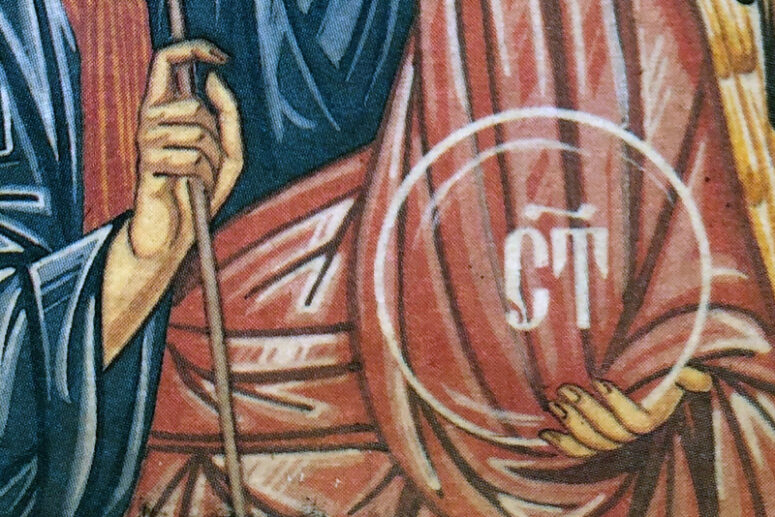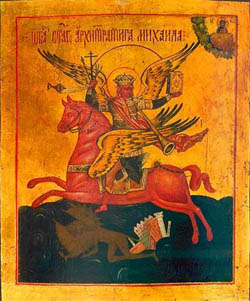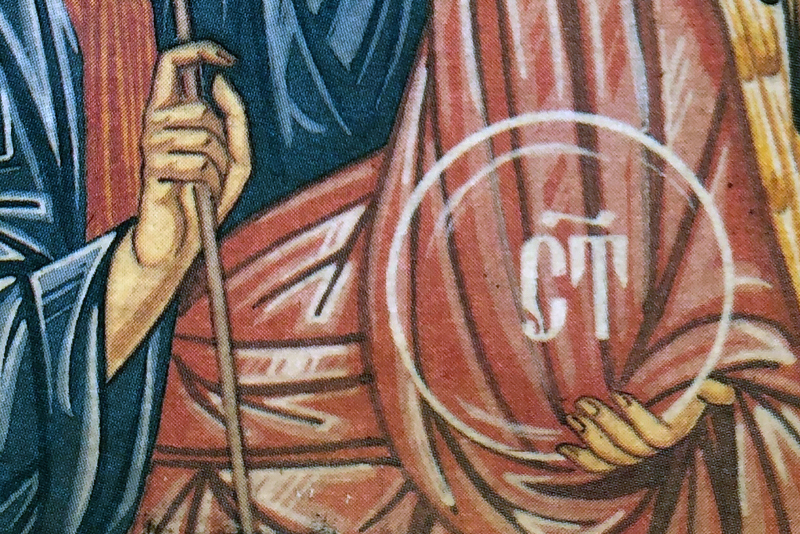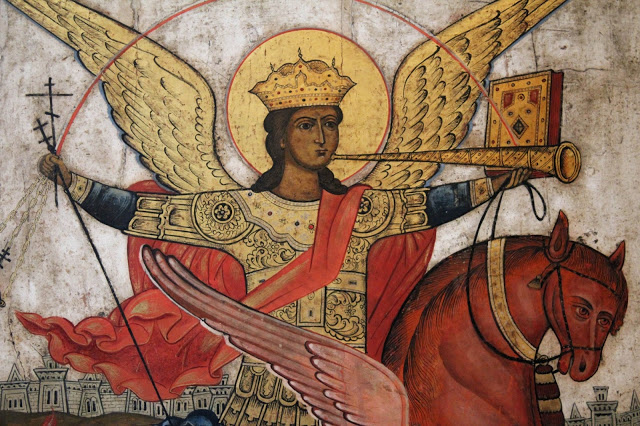
According to art critic Archpriest Boris Mikhailov, the image of an Angel, as we know it today, was formed as early as in the late 3rd – early 5th centuries. It is the image of a winged young man in an antique dress (the catacombs of Priscilla, second half of the 3rd century; catacombs under Villa Massimo and Via Latina in Rome, mid-4th century). The oldest surviving image of the angels known to the Christian East is the late 4th century marble sarcophagus found on the territory of modern Turkey. The soaring figures are holding in outstretched hands the monogram of Christ. The Greek letters “Iota” and “Chi” are forming a monogram “pre-Constantine” cross framed with a laurel wreath.
Angels are usually depicted in apostolic attire: a chiton (tunic) and a himation (a toga-like cloak), often with two ornamented stripes (clavi), symbolizing ambassadorship and royal greatness. The hair on their heads is pulled together by a ribbon resembling a diadem. The ends of these ribbons streaming down to the angels’ temples in Russian tradition are called “toroks” or “sluhi”. They symbolize the Angels constantly heeding the will of God.
Angel as the Reflection of the Face of God

It is curious that icons representing biblical stories with an unnamed angel often have an inscription: “Archangel Michael” and, conversely, depictions of the Bible scenes known to be appearances of the Archangel Michael are signed simply as “Angel of the Lord”. In the Old Testament, the Angel of the Lord symbolizes the Epiphany before the incarnation of the Son of God (for example, Jacob wrestled with God, who appeared to him in the image of an Angel (see Gen. 32, 24-30)). If we recall Dionysius the Areopagite, we will see the heavenly hierarchy as a system of mirrors, reflecting and transmitting between them the light from God, the ultimate source of everything for everyone. That being so, everything an angel does is ultimately done by God. Translated from Hebrew, “Michael” means the rhetorical question “Who is like God?” being, in essence, a reflection of the name of God. Both the archangel Michael and the Angel of the Lord appear on icons as a collective image of angelic forces.
What Angels Hold in Their Hands
A staff (measure) is the symbol of power, an important attribute of all angels, as well as a testament to their holiness and royal dignity.
A sphere or a mirror is mostly found in depictions of St Michael and St Gabriel. For the first time a mirror (with the image of a cross) appeared in the hands of an angel on the coins of the emperor Leontius (484-488). Its meaning is interpreted in different ways: the celestial sphere, symbolizing the universe, a shield, or “the seal of the Heavenly King.” In Medieval icons, the sphere is usually transparent with the Chi Ro monogram. There is a popular belief in Russian tradition that the mirror is an image of the archangels’ knowledge of the will of God, their contemplation of Divine secrets and Divine Light.
A censer and a ripidon (liturgical fan of a round or diamond shape) are held by angels on icons depicting the heavenly Liturgy. The ripidons symbolize Cherubims and Seraphims and are decorated with their images
A labarum (banner) served as the military standard of the emperor or king from the time of Emperor Constantine to the 13th century. Labarum in the hand of the Archangel (as in the 6th century mosaic in the church of St. Apollinaris in Classe, Ravenna) means that he is endowed with supreme power. As a rule, the labarum cloth is inscribed with the words from the “Agios” (“Holy”) doxology or the monogram of Christ.

Trumpets are symbols of sound and wind. These are mostly found in depictions of the Final Judgement, when the angels, including St Michael, will sound the end of the world.
The instruments of the Passion of the Lord – the cross, the spear, the cup and the cane with a sponge – are generally held by the archangels Michael and Gabriel. An angel with a cross in his hands appeared to Emperor Constantine in 312 before the battle with Maxentius. In ancient times, the angels were often depicted venerating the Cross and the instruments of the Passion, as, for example, on the back of the 12th century Novgorod icon of the Savior Not Made by Hands.
The veils borrowed from the court ceremony usually cover the angels’ hands during sacred rites.
Unrolled scrolls in the angels’ hands usually contain words of greeting (as on the scrolls held by the archangels Michael and Gabriel on the icons of the Mother of God), hymns of praise, instructions for those entering the temple, etc.
Translated by The Catalogue of Good Deeds
Based on materials from: http://www.nsad.ru/articles/kak-izobrazit-nepostizhimoe



